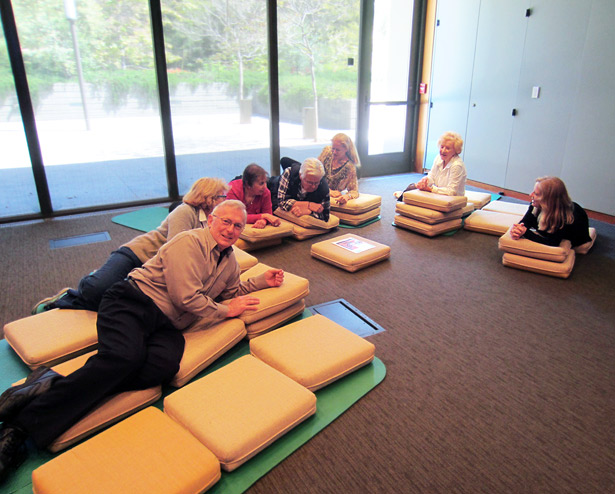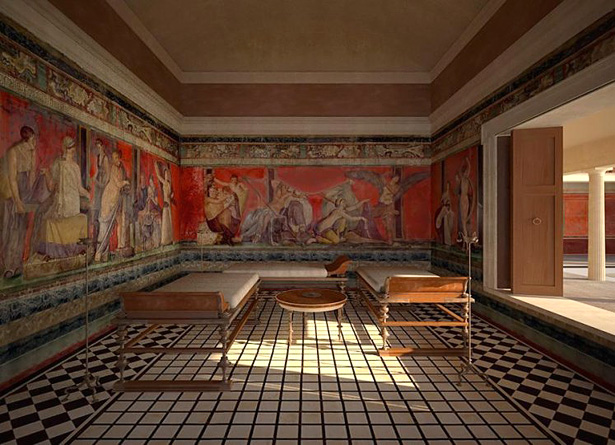The ancient Greeks had a recumbent approach to their (male-only) dinner parties, as I discussed in a previous post: elite men reclined, propped on pillows, to drink, converse, and—sometimes—overindulge.
The practice of reclining and dining continued into ancient Rome, but with a few additions—for one, respectable women were invited to join the party, and for another, drinking was not a separate, post-dinner event, but became part of the dining experience. An association of dining with luxury led to 19th-century depictions, like the one above, of Roman diners leading the soft life (here, without reclining).
The Greeks used single couches onto which companions were often squeezed for after-dinner drinking parties. The practice seems to have been adopted from the east, where it was a form of dining for elites. In Rome, couches for single (generally male) diners existed, but by the late Republican and early Imperial period the practice at dinner parties was for guests to recline on three large beds placed in a U shape in a triclinium (dining room). Reclining at parties continued to be primarily an elite practice—poorer people had no room for beds of this size. Although in the “old days” reclining had been shameful for respectable women, they now reclined with men, although some old fogeys disapproved, as we know from texts by Isidore of Seville (Etymologiae 20.11.9) and Valerius Maximus (De Institutis Antiquis 2.1.2).
Surviving triclinia with built-in cement dinner couches (the elegant mattresses long since destroyed by time) show that the beds were strongly angled upward to elevate the diner above the tabletop. In contrast, portable beds used cushions like those on Greek beds to elevate the diners.

Angled cement beds (mattresses missing) in the triclinium of the House of the Cryptoporticus, Pompeii. Photo: Ministro per la Coesione Territoriale, CC BY-NC-SA 2.0
As still happens at formal dinners today, places were designated for host, favored guests, and less-favored guests. In his Satire 8, the Roman poet Horace reveals “status seating” in action and shows how hard a Roman host (in this case, an unappreciated one) might work to impress a guest.
Ancient sources of course take it for granted that the reader knew all about dining protocol, and therefore authors didn’t bother to explain the rules for dining with crystal clarity. Scholars sometimes debate the locations of the best seats. (The Romans themselves called the reclining spots sedes, seats.) We know that the middle bed (lectus medius) offered a very good location, and there is evidence that the middle seat in this middle bed was an especially honorable one. Certainly it would have suited the Roman appreciation for symmetry. Queen Dido positioned herself “on a golden couch, in the middle,” when she feasted with Aeneas and Cupid, disguised as Aeneas’s son (Virgil, Aeneid 1.1.297–700).

This digital recreation of diners in the triclinium of the Roman villa at Boscoreale shows how the eyes of a person entering the dining room were drawn to the middle seat on the middle couch.
Guests reclining on this middle couch (lectus medius) could speak easily with the host to their right (on the low couch, lectus imus) and also look out at a view of the home’s courtyard or garden, a view carefully designed to impress, as shown on the seating diagram above. In contrast, diners on the high couch (lectus summus) to the left of the important guests (to the right of the person entering the room) could not see the view without twisting uncomfortably.

Re-creation of the layout of Roman dining beds using yoga mats and cushions (these “beds” are lacking legs to raise them off the floor). Villa docents Donald Peterson and Monica Wolfe each recline on the host bed (left, lectus imus), docents Ellie Rosen and Lou Rosen recline with me on the honorable guest bed (middle, lectus medius), and docents Jeanne Dahm and Karen Taylor make do with the lowest-status bed (right, lectus summus).
The re-creation of dining couches in the famous Villa of the Mysteries (below) shows how guest and host beds permitted a view out the main doorway (through which the viewer is entering), and in this case also into a peristyle at right, while the less important diners could only see the opulent wall paintings that decorated Roman triclinia—still not a bad view, however!

Digital reconstruction of the triclinium of the Villa of the Mysteries, Pompeii. Image copyright © 2011 and courtesy of James Stanton-Abbott
In time, Romans with space for serious entertaining increased the number of couches and hosted bigger dinner parties. Another type of couch, a semi-circular stibadium, eventually replaced the three beds. While literary descriptions of reclining and dining faded in the third century A.D., dining rooms for extremely wealthy recliners endure in the archaeological record into the sixth century. However, the collapse of the western Empire and the incursions of “barbarians” with newfangled dining agendas inevitably took their toll. In the eastern Empire, imperial dining rooms and elaborate church art still reference reclining and dining until A.D. 1000. Thus, the elitist practice of recumbent dining lasted the longest in the east, where it originated.
To explore more about the history of reclining and dining, see the entry in Brill’s New Pauly, and this article on status at mealtime in the Roman house. Or pull up a bed and crack open the wonderful book The Roman Banquet: Images of Conviviality by Katherine Dunbabin—along with, of course, a bottle of wine.





Thank you for this wonderful window into the ancient world. These pictures are so much more valuable than 1000 words. Please keep these reinactments coming.
Thanks for the text information and the pictures. They are helpful as was the great workshop.
Lou Rosen
Did the greeks and romans get pins and needles in the relining arm? Tried it and managed about 5 mins.
Loved the paintings; the models were superb; too bad Lap Bend Surgery wasn’t around then.
The size of the “couches” bothers me. The docents seem to be on individual couches about 2’x5′. So three diners need three 2’x5′ couches. But the “digital reconstruction” and the ancient triclinium all only have ONE (2’x5′) couch on each side. How could NINE people dine there?
Well, they could have one big couch in a “U” shape, or, they can have 3 couches, in a shape of a lopsided “U”
Dear Paula,
The docent couches look confusing because we used yoga mats and cushions to separate each diner. Each group of three docents is, however, supposed to be reclining on one large bed. Their individual “sedes” (reclining area) on the bed is indicated by a mat. In the diagram showing guest and host beds, each bed is 6 or 7 feet long and can hold three people.
I found this very interesting and informative – but I have read through the descriptions of your re-enactment seating several times and I wonder if you have got right-hand and left-hand muddled up? It looks to me as though diners on the high couch could see the view quite easily. Or is the window behind the middle couch not the view to which you refer?
get rid of the fat man eating BUT LOL
Was there a standard bidding formula to call guests “to table” after their arrival and reception in the house?
Hi John,
There was no tradition of gathering in a “living room” or parlor to chat before the dinner party. Probably the guests were led straight to the triclinium and there awaited the arrival of any who were not on time, until the host decided to start serving. A slave would remove guests’ shoes, clean and wipe their feet, and rinse their hands. Guests then settled themselves on the couches and probably were offered a refreshing drink and appetizers. In Petronius’s Satyricon (30.5–6), a host who is a former slave, not well educated—and very superstitious—has posted a boy by the threshold to the dining room to call out “Pede dextro!” to guests about to enter. The reminder “With the right foot” was to ensure that everyone would enter with his lucky foot. It was a common notion that stepping into a new location with the right foot was a good omen, but this was an unusual “call to table.”
how long would a Roman Dinner party last?
From late afternoon through late night. Must have had long pauses between courses.
Hi Ceceli,
Dinner parties were as variable in length as ours. A Roman dinner offered three courses at a minimum, and often many more. An elaborate Roman “tasting menu” aimed at really impressing the guests could last many hours, as today. Roman foodies dragged out a pleasant dinner with elite food and surprising dishes, entertainments between courses, and conversational games.
Thanks so much, this really helped with my Ancient Rome project.
I am writing a Roman letter and this helped soooooooooooooo much! Thanks you. not from american person.
Wow! It’s very amazing! Even in my 20+ years of learning I did not know this!
This has solved a puzzle for me, thanks! I just couldn’t envisage how this could work without giving my neighbours the “cold shoulder” for half the meal.
Is the above painting “A Roman Feast” by Roberto Bompiani in the Open Content Program?
Yes, Roberto Bompiani’s A Roman Feast is available for download from the Getty Museum’s Online Collection.